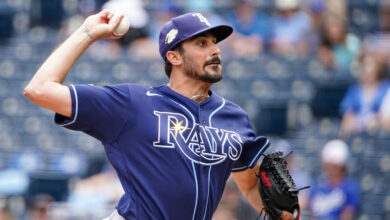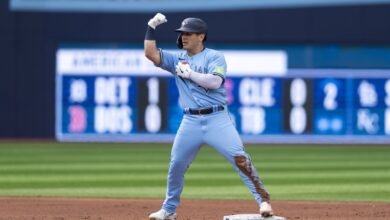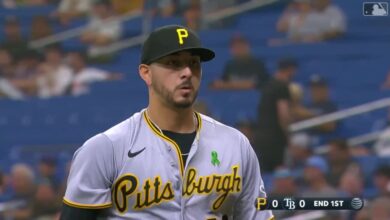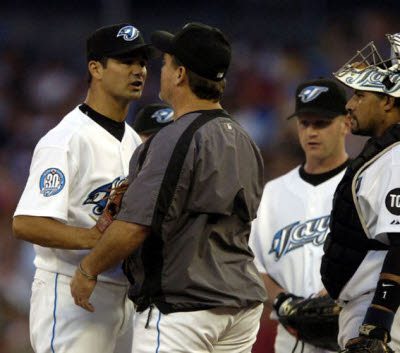
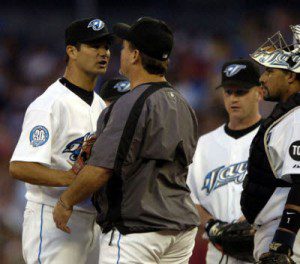
As recently as last weekend, the Toronto Sun was reporting that the Toronto Blue Jays’ managerial search had been narrowed down to Jim Tracy and Jim Riggleman.
Then, out of the blue on Tuesday, the Blue Jays announced that John Gibbons would be returning to the job he held from 2004-08.
Gibbons joins a small group of managers since the end of World War II to come back for a second tour of duty with the same team. History shows mixed returns for managers who make a return to a job they once held, not including interim assignments.
Probably the best second-chance skipper was Bobby Cox of the Atlanta Braves.
He managed the Braves from 1978-81 with a high-water mark of 81-80 in 1980. His record during his first five-year stint in Atlanta was just 266-323. After a disappointing 50-56 record during the strike-shortened 1981 campaign, Braves owner Ted Turner fired Cox.
Toronto wasted no time snapping up the 40-year-old skipper, and he led the Blue Jays to their first postseason appearance in 1985. Shortly after Toronto coughed up a 3-1 series lead to the Kansas City Royals in the American League Championship Series, Cox returned to Atlanta, this time as general manager.
In June 1990, Cox fired manager Russ Nixon and took over the dugout duties, then relinquished control of the front office to John Schuerholz that October to focus on managing.
What happened next? Just 14 division titles, five National League pennants and a World Series title in 21 seasons. Cox managed the Braves to a 1,883-1,386 record from 1990-2010 and is should be inducted into the Hall of Fame at some point in the near future.
It hasn’t always gone so well on the reunion tour, however.
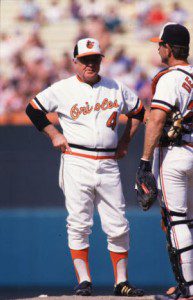
In 1985, the Baltimore Orioles brought back Earl Weaver, who had led the club to four American League pennants and a World Series title his first time around from 1968-82. Taking over for Joe Altobelli, the man who replaced him when he retired after the 1982 season, Weaver lasted just 1½ years in his return.
The Orioles were just 126-141 and Weaver returned to retirement permanently after the 1986 season.
The Boston Red Sox fired Pinky Higgins in early July 1959 after 4½ seasons. Higgins had guided the Sox to first-division finishes in each of his first four seasons (1955-58), but he was fired with the team in last place in 1959.
He wasn’t gone a year before he was brought back. Billy Jurges was fired shortly after leaving the club for health reasons in June 1960 and Higgins was brought back. After three straight second-division finishes, Higgins was done for good after the 1962 season.
The Chicago White Sox tried twice to recapture the magic from a pair of managers from the 1950s. In 1959, Al Lopez guided the team to its first American League pennant since the 1919 Black Sox scandal and in nine seasons from 1957-65, Lopez never had a losing season and Chicago won at least 90 games five times. Lopez retired to the White Sox front office after the 1965 season with a record of 811-615.
In 1968, Lopez returned to the dugout after Eddie Stanky and Les Moss had guided the team to a 47-69 record. The White Sox improved a bit after Lopez returned, finishing 21-26 and finishing eighth in the 10-team league.
His second tenure ended in April 1969, when he retired due to health concerns. Chicago was 8-9 at the time and finished 68-94.
In 1976, the White Sox again reached into their past … in this case way back into their past. Paul Richards had managed the team from 1951 until he was fired late in the 1954 season despite the White Sox having a 91-54 record at the time, their most wins since 1917.
Richards had been out of baseball for 3½ years when owner Bill Veeck came calling in the fall of 1975. Richards managed the White Sox for just one year. The team finished 64-97 and Richards was fired at season’s end.
Under George Steinbrenner’s reign, the New York Yankees fired and re-hired managers with alarming regularity. Billy Martin alone had five separate tenures as manager.
Prior to Steinbrenner purchasing the club, Ralph Houk spent three years managing the Yankees, winning three straight pennants from 1961-63 and was promoted to general manager. In 1966, with the club struggling under Johnny Keane, Houk took the job back and stayed there until the end of the 1973 season. The team never returned to the postseason during Houk’s second tenure and he earned the distinction of becoming the first of the 8,201,406 (number approximate) to be fired by Steinbrenner.
Alvin Dark had two tenures as manager of the Athletics, once in Kansas City (1966-67) and again in Oakland (1974-75). His first tour was not good (126-155). But after taking over for Dick Williams following the 1973 season, Dark was 168-136 in two seasons. Of course, it does help to inherit the defending World Series champions.
Charlie Grimm was the last manager to win a pennant with the Chicago Cubs in 1945, a year after taking over from Jimmie Wilson. After a 19-31 start in 1949, Grimm was fired but returned to replace Bob Scheffing after the 1959 season. But after the team stumbled out of the gate with six wins in its first 17 games, owner Philip Wrigley pulled off one of the strangest moves ever. Lou Boudreau was hired out of the Cubs’ radio booth to manage the team, and Grimm was sent up to the press box to replace Boudreau on the broadcasts.
Of course, in 1961 Wrigley had his “college of coaches” idea with rotating managers for two seasons, so swapping the radio guy for the manager doesn’t even count as his strangest managerial move.
George Bamberger led the Milwaukee Brewers to their first winning season in 1978 and improved that win total from 93 to 95 in 1979. But after having heart problems in 1980, he resigned and was replaced by Buck Showalter.
However, Bamberger was brought back in 1985 with much less promising results. The Brewers were 142-171 and he was replaced by Tom Trebelhorn in September 1986.
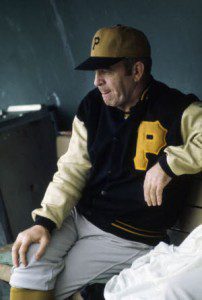
As manager of the Philadelphia Phillies, Eddie Sawyer led the team to its first National League pennant in 35 years when he guided the Whiz Kids to the 1950 NL crown. He was let go in June 1952 but was brought back after Mayo Smith was fired in 1958. Sawyer’s Phils finished last in 1959, and he quit after losing on opening day in 1960.
His quote when he left the Phillies for the final time was at least memorable.
“I’m 49 years old and I want to live to be 50,” Sawyer said after he resigned following a 9-4 loss to the Cincinnati Reds.
Danny Murtaugh had three stints as manager of the Pittsburgh Pirates, working in the front office between them. Murtaugh replaced Bobby Bragan with the club at 36-67 in 1957 and led them to a winning record (26-25) the rest of the way. It wasn’t a fluke. The Pirates climbed out of nearly a decade in the National League cellar, going 84-70 in 1958 and winning the World Series in 1960.
Murtaugh moved upstairs after the 1964 season and replaced himself in the dugout with Harry Walker. He fired Walker and was the interim manager for the final 78 games of the 1967 season, then took over the job full-time again in 1970.
The Pirates won the National League East in both 1970 and 1971 and after winning another World Series title in 1971, Murtaugh again handed off the lineup card, this time to Bill Virdon.
Murtaugh made one final trip back to the dugout, replacing Virdon in 1973 and staying on through the 1976 season. He retired after the season and tragically died of a stroke two months later at the age of 59.
Bill Rigney’s two stints with the San Francisco Giants came nearly 20 years apart. Rigney replaced Leo Durocher while the franchise was still in New York after the 1955 season. After the move west in 1958, Rigney lasted another 2½ seasons before he was fired in June 1960. Rigney was brought back after the 1975 season to replace Wes Westrum but lasted just one year, going 74-88 and getting fired at season’s end.
This isn’t even the Blue Jays’ first rodeo with a second-time manager. Cito Gaston led the team to its only World Series titles during his first tenure on the job from 1989-97, then in a nice twist of coincidence, was named to replace Gibbons when he was canned in 2008.
Gaston led the Jays to a 211-201 record from 2008-10 before he retired and was replaced by John Farrell, who returned to Boston in October.
Gibbons now replaces Farrell. How will it go the second time around?
It can’t hurt that he will be a beneficiary of the Miami Marlins’ most recent fire sale. Having Jose Reyes to anchor the top of the order and adding Josh Johnson and Mark Buerhle to the starting rotation is a nice way to start over.



